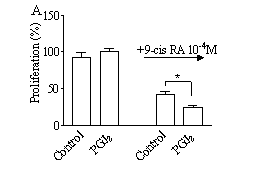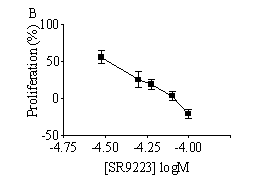| pA2 online © Copyright 2004 The British Pharmacological Society |
103P
GKT, University of London Winter Meeting December 2003 |
|
Inhibition
of proliferation by RXR & FXR nuclear receptor ligands in lung
cells |
|
The Retinoid X Receptor
(RXR) is the obligate heterodimeric partner of many nuclear receptors,
including peroxisome proliferators-activated receptors (PPAR; Bishop-Bailey,
2000). The dimer then binds to PPAR response elements (PPRE) on target
genes and initiates transcription. The RXR receptor exists in three isoforms,
![]() , ß and g,
and are all activated by the endogenous ligand 9-cis retinoic acid
(9-cis RA). The Farnesoid X Receptor (FXR) is also a dimer partner with
RXR and its main function is in bile acid synthesis and transport, however
it also leads to apoptosis in many cells types (Willson, 2001). In this
current study we have cultured lung fibroblasts from mice and compared
their responses in the presence and absence of ligands for RXR, FXR and
PPAR receptors.
, ß and g,
and are all activated by the endogenous ligand 9-cis retinoic acid
(9-cis RA). The Farnesoid X Receptor (FXR) is also a dimer partner with
RXR and its main function is in bile acid synthesis and transport, however
it also leads to apoptosis in many cells types (Willson, 2001). In this
current study we have cultured lung fibroblasts from mice and compared
their responses in the presence and absence of ligands for RXR, FXR and
PPAR receptors.
Lungs from wild-type control (BLK6) mice (male, 24grams) were cultured into supplemented DMEM using standard explant protocols (Stanford et al., 2003). Explanted cells were detached and re-seeded at 40% confluence in 96-well plates. 24 h later the medium was replaced with fresh DMEM containing BSA (0.1%) but no FCS. Cells were then rested for 2 h before the addition of test drugs or vehicle controls. 4 h later proliferation was stimulated by the addition of FCS (3 %) and cells were then incubated (5% CO2 in air; 37 °C) for a further 72 h. Proliferation was quantified using a fluorescence assay (CYQUANT; Cambridge Bioscience).
9-cis RA inhibited murine lung cell proliferation at the highest dose, 10-4M caused a reduction of 42±4% compared to control (fig 1A).The addition of 10-5M 15d-PGJ2, a PPAR ligand, to cells does not cause any reduction in cell proliferation (100±4%), however when the two drugs are added together they show a synergy in their response by inhibiting proliferation by 24±3% at 10-4M 9-cis RA.


Effects
of 9-cis RA ± 10µM 15deoxy-![]() 12,14-PGJ2
(A) or SR9223 (B) on proliferation of lung fibroblasts from control. Proliferation
is calculated as % of induced growth in response to FCS. Data is mean
± s.e.m for n=6 from 2 animals (A) and n=3 from 1 animal (B). *p,0.05;
Students t test.
12,14-PGJ2
(A) or SR9223 (B) on proliferation of lung fibroblasts from control. Proliferation
is calculated as % of induced growth in response to FCS. Data is mean
± s.e.m for n=6 from 2 animals (A) and n=3 from 1 animal (B). *p,0.05;
Students t test.
The FXR ligand SR9223 caused inhibition in proliferation with a threshold concentration of 3x10-5M (fib 1B) and at doses >8x10-5 M the lung cells started to undergo apoptosis. SR9223 does not show any synergy with 15d-PGJ2 (data not shown).
These data show that the addition of ligands for both RXR and PPAR can act synergistically to inhibit the proliferation of lung cells, and that the FXR receptor also plays a role in the induction of apoptosis. Together these data provide implications for the development of novel therapeutic drugs for the treatment of pulmonary hypertension.
Bishop-Bailey, D
(2000), Br J Pharmacol 129: 823-834.
Stanford, SJ, et al. (2003), Eur J Pharmacol 473:
135-141.
Willson, TM (2001), Med Res Rev 21: 513-522.
This work was funded by the JRB St Bartholomews Hospital, London.